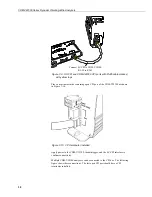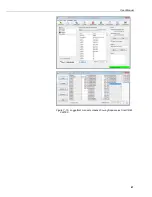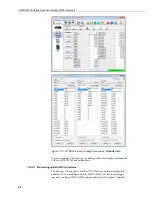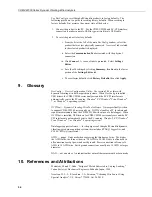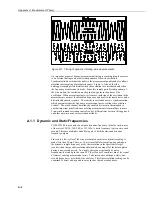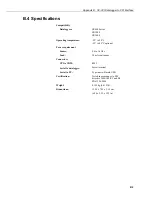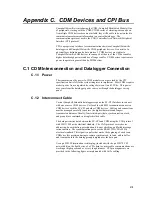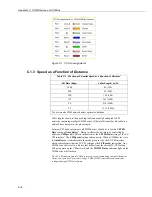
CDM-VW300 Series Dynamic Vibrating-Wire Analyzers
52
Low-amplitude warning flag
— flag is set true when the resonant amplitude of
the vibrating wire falls to or below 50% of the value entered in
DVWTool
or
CDM_VW300Config()
. Resonant amplitude must be maintained higher than
50% to ensure an accurate measurement.
High-amplitude warning flag
— flag is set true when the resonant amplitude of
the vibrating wire reaches or exceeds 200% of the value entered in
DVWTool
or
CDM_VW300Config().
Resonant amplitude must be maintained less than 200%
to ensure an accurate measurement.
Low-frequency warning flag
— flag is set true when the frequency of the
vibrating wire falls between the
Actual Min Freq (Hz)
shown in
DVWTool
and
the
Minimum Frequency (Hz)
entered in
DVWTool
. The
CDM_VW300Config()
instruction equivalent to
Minimum Frequency (Hz)
is
the
LowFreq
parameter. When a low-frequency limit is entered into
DVWTool
or
the CRBasic program, an error window is created that spans the bandwidth
between the frequency cut-off requested (
Minimum Frequency
or
LowFreq
) and
the frequency cut-off the analyzer can actually establish (
Actual Min Freq
). If a
measured frequency falls within the error band, the low-frequency warning flag is
set true. For example, if a low-frequency limit of 500 Hz is entered, and the
closest the analyzer can come to complying is to set the limit at 476.85 Hz, any
frequency below 476.85 Hz is discarded, and any frequency above 476.85 Hz is
used. However, any frequency between 476.85 Hz and 500 Hz will activate the
low-frequency warning flag, indicating that the data includes at least one
measurement below the user set limit. See Section 8.5.1.2,
Calculating Low- and
High-Frequency Boundaries
, for more information.
High-frequency warning flag
— flag is set true when the frequency of the
vibrating wire falls between the
Actual Max Freq (Hz)
shown in
DVWTool
and
the
Maximum Frequency (Hz)
entered in
DVWTool
. The
CDM_VW300Config()
instruction equivalent to
Maximum Frequency (Hz)
is
the
HighFreq
parameter. When a high-frequency limit is entered into
DVWTool
or the CRBasic program, an error window is created that spans the bandwidth
between the frequency cut-off requested (
Maximum Frequency
or
HighFreq
)
and the frequency cut-off the analyzer can actually establish (
Actual Max Freq)
.
If a measured frequency falls within the error band, the high-frequency warning
flag is set true. For example, if a high-frequency limit of 1000 Hz is entered, and
the closest the analyzer can come to complying is to set the limit at 1049.07 Hz,
any frequency above 1049.07 Hz is discarded, and any frequency below 1049.07
Hz is used. However, any frequency between 1000 Hz and 1049.07 Hz will
activate the high-frequency warning flag, indicating that the data include at least
one measurement above the user set limit. See Section 8.5.1.2,
Calculating Low-
and High-Frequency Boundaries
, for more information.
8.5.1.2
Calculating Low- and High-Frequency Boundaries
The easiest way to minimize the size of the low- and high-frequency error
windows is to enter estimated limits into the
Minimum Frequency
and
Maximum Frequency
columns in the
DVWTool
main screen, record the resulting
values displayed in the
Actual Min Freq
and
Actual Max Freq
columns, then
turn around and enter those values back into the
Minimum Frequency
and
Maximum Frequency
columns or the
LowFreq
and
HighFreq
parameters in the
CDM_VW300Config()
CRBasic instruction.
However, to calculate the actual-minimum and actual-maximum frequencies, use
the information in Table 8-1 to size the value. For example, to calculate the
actual-minimum frequency, assuming a measurement is to be taken at a scan rate
of 20 Hz, use an integer multiple of 47.68 to calculate the actual-minimum
frequency. If the low-frequency limit is estimated to be 150 Hz, enter 3 x 47.68,
Summary of Contents for CDM-VW300 Series
Page 2: ......
Page 4: ......
Page 6: ......
Page 12: ......
Page 59: ...User Manual 47 Figure 7 16 LoggerNet connect screens showing frequencies from CDM VW300 ...
Page 70: ...CDM VW300 Series Dynamic Vibrating Wire Analyzers 58 ...
Page 76: ...Appendix B SC CPI Datalogger to CPI Interface B 4 ...
Page 80: ...Appendix C CDM Devices and CPI Bus C 4 Figure C 2 Long cable lengths of a distributed CPI bus ...
Page 86: ...Appendix E Calculating Measurement Error E 4 ...
Page 116: ...Appendix G CRBasic Program Library G 26 ...

